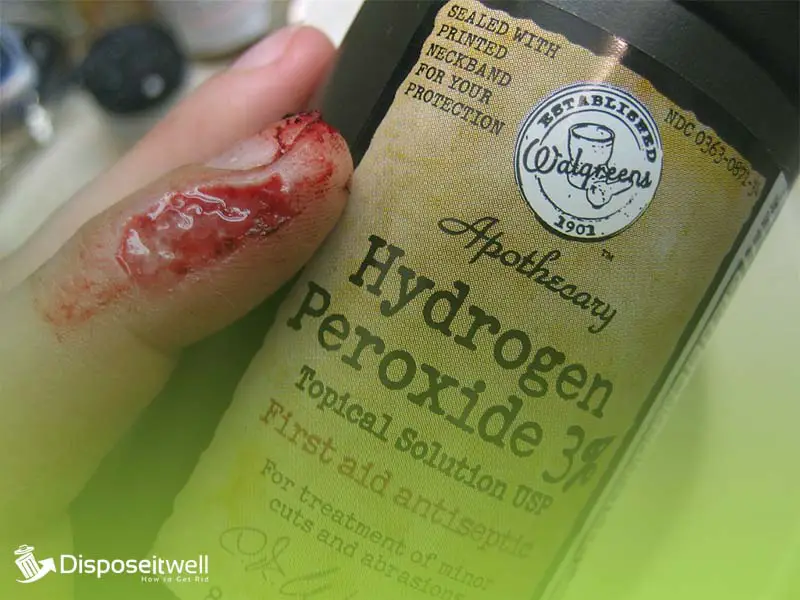So, you’ve got some hydrogen peroxide lying around and you’re not quite sure what to do with it? Don’t worry, we’ve got you covered.
While hydrogen peroxide is great for cleaning wounds and disinfecting surfaces, it’s not exactly something you can just throw in the trash. In fact, improperly disposing of hydrogen peroxide can be hazardous and damaging to the environment.
So, how do you dispose of hydrogen peroxide? The first step is to determine the concentration of your hydrogen peroxide solution. This can usually be found on the label of the bottle. If it’s a concentration of 5% or lower, you can safely pour it down the drain with plenty of water. However, if the concentration is higher than 5%, you’ll need to take a different approach.
But fear not, because we’ve got some simple and fun solutions for safely disposing of your hydrogen peroxide. Whether you’re a germaphobe or just cleaning out your medicine cabinet, we’ve got your back.
So sit back, relax, and let us guide you through the process of getting rid of that hydrogen peroxide once and for all!
Is Hydrogen Peroxide Toxic?
Hydrogen peroxide (H2O2) is a naturally occurring substance found in small amounts in the environment as well as in the human body. It is commonly used as an antiseptic for minor cuts and scrapes, as well as to whiten teeth and disinfect surfaces. It is also used in some industrial processes.
In small concentrations, hydrogen peroxide is generally considered safe. However, in higher concentrations, hydrogen peroxide can be toxic and even deadly.
Hydrogen peroxide is considered to be a non-toxic chemical, however, it is corrosive and can cause serious skin, eye, and internal organ damage if not handled properly. The toxicity of hydrogen peroxide depends on the concentration and duration of exposure.
Low concentrations of hydrogen peroxide, such as those found in household products, are generally non-toxic and safe for use. However, higher concentrations of hydrogen peroxide, such as those found in industrial and laboratory settings, are more toxic.
In addition to being corrosive, hydrogen peroxide can also be explosive if heated or mixed with certain chemicals. It is important to follow all safety guidelines when using hydrogen peroxide. It is also important to never use it undiluted, as even small amounts can cause irritation.
The bottom line is that hydrogen peroxide can be toxic when misused, but when used correctly, it can be quite beneficial. As with any potentially hazardous material, it is important to use caution and follow directions when handling it.
Negative Effect Of Hydrogen Peroxide
Hydrogen peroxide (H2O2) is a colorless, odorless liquid commonly used as a disinfectant, bleach, and oxidizing agent. While hydrogen peroxide has many positive uses, it can have several negative effects.
The most significant negative effect of hydrogen peroxide is its potential to cause skin and tissue damage when used in concentrations that are too strong, or when used too frequently. Hydrogen peroxide can cause a burning sensation, stinging, and reddening of the skin when used at too high of a concentration. Overuse of hydrogen peroxide can also cause skin irritation, dryness, and peeling.
When taken orally, hydrogen peroxide can cause gastrointestinal distress such as nausea, vomiting, and abdominal pain. Inhaling hydrogen peroxide vapor can cause respiratory irritation, coughing, shortness of breath, and wheezing. Severe cases may require hospitalization and oxygen therapy.
Ingestion of hydrogen peroxide in concentrations higher than 5% can cause stomach irritation, vomiting, and diarrhea, and can even lead to more serious health problems such as burns or ulcers. Inhalation of hydrogen peroxide vapors can also cause irritation to the lungs, nose, and throat.
In addition, hydrogen peroxide can be toxic to aquatic organisms and certain plants, so care must be taken when using it near water sources. The environmental impact of hydrogen peroxide can be minimized by using the minimum amount necessary to achieve the desired results, and by properly disposing of any excess.
Overall, hydrogen peroxide is a useful chemical but can have serious negative effects when used improperly. It is important to use hydrogen peroxide only as directed and to follow all safety precautions.
Can You Drain Down Hydrogen Peroxide?

Yes, you can drain down hydrogen peroxide and the process is fairly simple and doesn’t require any special equipment. According to thehealthyjournal, you can drain down Hydrogen Peroxide without any special treatment.
But to be on the safe side you’ll need to make sure the hydrogen peroxide is diluted to an appropriate concentration level. Then, you’ll need to open up a drain and slowly pour the hydrogen peroxide down the drain.
As it goes down the drain, you’ll start to see the peroxide bubbling away as it breaks down. This process will help to remove any build up of bacteria or other contaminants in the drain. After the peroxide has drained away, you can flush the drain with hot water to remove any remaining residue. With that, you can now say goodbye to your hydrogen peroxide problem!
How To Dispose Of Hydrogen Peroxide
Disposing of hydrogen peroxide can be a bit confusing as the process varies depending on the type and condition of the chemical. In this guide, I will walk you through the different methods for disposing of hydrogen peroxide safely and responsibly, so you can feel confident in knowing you’re doing your part to protect both your home and the environment.
Food-Grade Hydrogen Peroxide
Food-grade hydrogen peroxide is used as a natural disinfectant and preservative in the food industry. It can be used to sanitize food preparation surfaces, equipment, and packaging materials. It is also used to wash fruits and vegetables to remove bacteria and other contaminants. In addition, food-grade hydrogen peroxide can be used as a bleaching agent to whiten flour and other food products.
Note: It’s important to note that although food-grade hydrogen peroxide is safe for human consumption when used properly, undiluted hydrogen peroxide or higher concentrations can be dangerous and should not be ingested. It’s important to always follow the manufacturer’s instructions and use caution when handling any form of hydrogen peroxide. Therefore it’s safe disposal becomes important and necssary thing to do. Here is easy way to do it.
Process:
1. Dilute food grade hydrogen peroxide with water to the desired concentration.
2. Apply the diluted solution to the surface to be sanitized.
3. Allow the solution to contact the surface for at least one minute.
4. Rinse the surface with potable or clean water.
5. Dry the surface with a clean cloth or paper towel.
Disposal:
1. If the solution is not contaminated, then it can be poured down the drain.
2. If the solution is contaminated, then it must be treated as hazardous waste and disposed of in accordance with local, state, and federal regulations.
3. Empty containers should be triple-rinsed with water and disposed of in accordance with local, state, and federal regulations.
Expired Hydrogen Peroxide
Expired hydrogen peroxide is a chemical compound that has reached the end of its shelf life and can no longer be used for its intended purpose. It is an oxidant, meaning it can react with other substances to break them down into smaller molecules. It is typically two years after it is manufactured (Source). After that time, the concentration of active ingredients decreases and the effectiveness of the product diminishes.
The expired hydrogen peroxide can safely be poured down the sink, flushed down the toilet, or disposed of in the trash. It can also be treated with a catalyst such as manganese dioxide and then neutralized with a base, such as sodium bicarbonate, to make it safe for disposal.
Using an absorbent material such as sawdust, sand, or cat litter can also work in favor of disposing of hydrogen peroxide. Simply pour the hydrogen peroxide onto the absorbent material and allow it to soak in. Once it has been completely absorbed, it can be placed in a sealed container and disposed of with regular household garbage.
Safety Tips For Disposing of Hydrogen Peroxide
Here are some safety tips when disposing of hydrogen peroxide:
1. Wear appropriate safety gear
When handling and disposing of hydrogen peroxide, make sure to wear safety goggles, gloves, and other protective clothing. This will help to protect your skin and eyes from any splashes.
2. Keep away from open flames
Hydrogen peroxide is flammable and should be kept away from open flames, sparks, or any other source of ignition.
3. Use appropriate containers
Make sure to use an appropriate container to store and transport hydrogen peroxide. The container should be airtight and have a secure lid to prevent accidental spills.
4. Do not mix with other chemicals
Do not mix hydrogen peroxide with other chemicals as this can create hazardous reactions.
5. Dispose of properly
Dispose of hydrogen peroxide in accordance with local regulations. This may include taking it to a hazardous waste facility or following instructions from the manufacturer. Do not pour it down the drain or onto the ground.
Verdict
The disposal of hydrogen peroxide depends on its concentration. Hydrogen peroxide with a concentration of less than 5% can be poured down the drain with plenty of water. For a concentration of 10-50%, it should be diluted with an equal volume of water and flushed down the drain with plenty of water.
With a concentration greater than 50%, it should be collected and disposed of by a professional waste disposal company. Additionally, it is important to check with local authorities for specific regulations regarding the disposal of hydrogen peroxide, as it may vary from place to place.

Gemma Alexander has an M.S. in urban horticulture and a backyard filled with native plants. After working in a genetics laboratory and at a landfill, she now writes about the environment and recycling topics.

